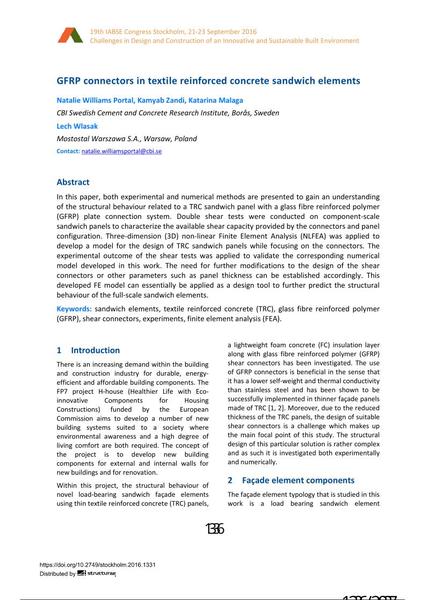GFRP connectors in textile reinforced concrete sandwich elements

|
|
|||||||||||
Bibliografische Angaben
| Autor(en): |
Natalie Williams Portal
(CBI Swedish Cement and Concrete Research Institute, Borås, Sweden)
Kamyab Zandi (CBI Swedish Cement and Concrete Research Institute, Borås, Sweden) Katarina Malaga (CBI Swedish Cement and Concrete Research Institute, Borås, Sweden) Lech Wlasak (Mostostal Warszawa S.A., Warsaw, Poland) |
||||
|---|---|---|---|---|---|
| Medium: | Tagungsbeitrag | ||||
| Sprache(n): | Englisch | ||||
| Tagung: | IABSE Congress: Challenges in Design and Construction of an Innovative and Sustainable Built Environment, Stockholm, Sweden, 21-23 September 2016 | ||||
| Veröffentlicht in: | IABSE Congress Stockholm, 2016 | ||||
|
|||||
| Seite(n): | 1336-1343 | ||||
| Anzahl der Seiten (im PDF): | 8 | ||||
| Jahr: | 2016 | ||||
| DOI: | 10.2749/stockholm.2016.1331 | ||||
| Abstrakt: |
In this paper, both experimental and numerical methods are presented to gain an understanding of the structural behaviour related to a TRC sandwich panel with a glass fibre reinforced polymer (GFRP) plate connection system. Double shear tests were conducted on component-scale sandwich panels to characterize the available shear capacity provided by the connectors and panel configuration. Three-dimension (3D) non-linear Finite Element Analysis (NLFEA) was applied to develop a model for the design of TRC sandwich panels while focusing on the connectors. The experimental outcome of the shear tests was applied to validate the corresponding numerical model developed in this work. The need for further modifications to the design of the shear connectors or other parameters such as panel thickness can be established accordingly. This developed FE model can essentially be applied as a design tool to further predict the structural behaviour of the full-scale sandwich elements. |
||||
| Stichwörter: |
Finite-Elemente-Analyse
|
||||
